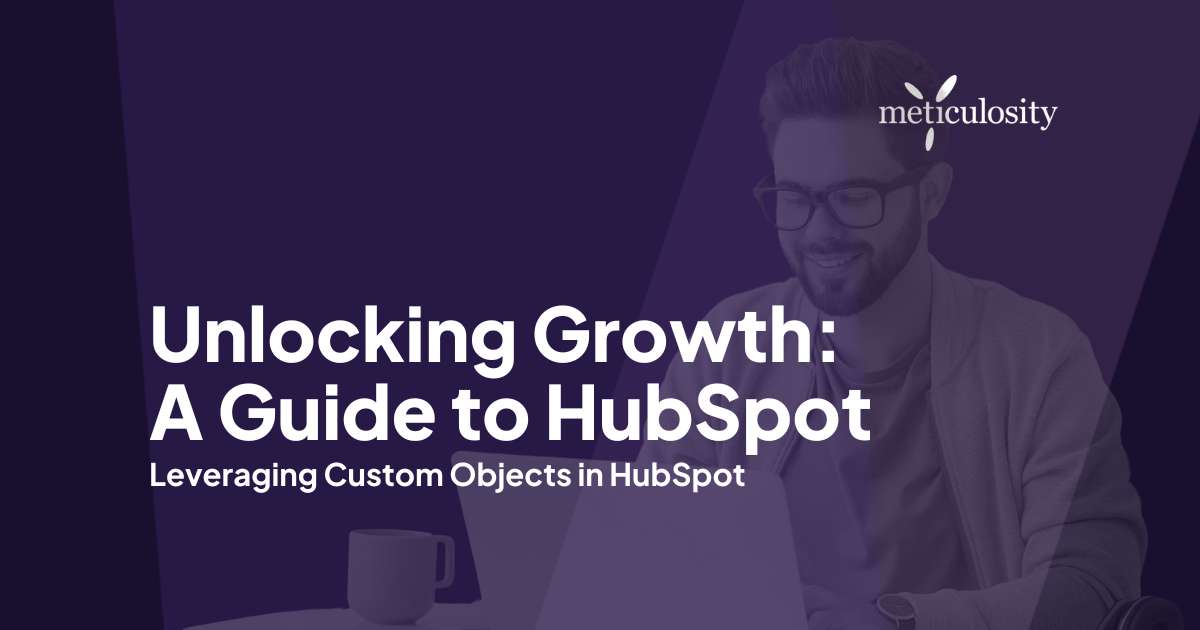Many businesses need help growing and managing their customer data effectively. HubSpot Custom Objects can provide a solution. This guide will show you how to use these tools to boost your growth and streamline processes. Follow along to find out how.
Understanding HubSpot Custom Objects
HubSpot Custom Objects serve specific purposes and offer various benefits. Leveraging these custom objects supports tailored marketing strategies, targeted segmentation, and data management for growth.
Ready to elevate your HubSpot Partner Agency? Learn more here.
Definition and Purpose
Custom objects in HubSpot serve a critical role by allowing the customization and management of data that standard options do not support. They help create specific data structures tailored to unique business needs, ensuring better segmentation, personalization, and targeted marketing strategies.
This flexibility aids businesses in organizing their CRM database more effectively, making it easier to track and manage customer interactions and information beyond the conventional fields.
Utilizing custom objects extends to enhancing growth strategies through improved data management. It enables businesses to segment their audience more accurately, tailor their marketing efforts based on detailed insights, and achieve higher levels of personalization in their communication.
This level of customization ensures that companies can design and implement targeted campaigns with higher efficiency, ultimately leading to enhanced customer engagement and increased sales opportunities.
Benefits of Custom Objects
Custom objects in HubSpot offer businesses a powerful tool for segmentation and personalization. They enable companies to create specific data structures that align perfectly with their unique business processes.
This customization improves CRM database management, making storing, accessing, and analyzing customer data easier. With custom objects, businesses can go beyond generic customer profiles to develop deeper insights into their needs and behaviors.
Leveraging these tailored insights leads to more effective targeted marketing strategies. Sales teams gain the ability to craft highly personalized outreach efforts, significantly boosting conversion rates.
For marketing professionals, this means creating campaigns that resonate closely with each audience segment. Automation also becomes more impactful, allowing for smoother operations and enhanced growth strategy implementation.
Next, we explore examples of how custom objects can be utilized effectively in HubSpot.
Examples of Custom Objects
Custom Objects in HubSpot allow the utmost data management and segmentation flexibility. They enable businesses to store unique data, facilitating personalized marketing strategies and more effective growth tactics.
- Project Management Records: Companies can create custom objects to track individual projects within HubSpot. This ensures all project-related data, from timelines to resources, is easily accessible, enabling precise management and targeted communication with stakeholders.
- Subscription Details: For businesses that offer subscription-based services or products, custom objects can keep detailed records of each customer's subscription type, duration, and renewal date. This insight aids in tailoring marketing efforts and automating renewal reminders.
- Course Enrollments: Educational institutions or businesses providing courses can use custom objects to manage student enrollments. By tracking course selections, progress, and completion rates, educators personalize communications and support for each student.
- Warranty Information: Retailers or manufacturers can leverage custom objects to manage product warranty details. Storing start dates, end dates, and coverage specifics helps automate the warranty service process and enhances customer support.
- Equipment Rentals: For companies that rent out equipment or other items, custom objects track each rental's duration, condition upon return, and cost. This system streamlines billing processes and inventory management.
- Real Estate Listings: Real estate agencies benefit from custom objects by keeping detailed property listing records, including location details, price range, open house dates, and agent contact information. These records enable targeted outreach to potential buyers based on their preferences.
By utilizing these examples of custom objects in HubSpot, organizations optimize their CRM system for better data management practices, leading to more effective growth strategies through personalized marketing efforts.

Creating and Managing Custom Objects
Creating and managing custom objects involves defining specific data fields tailored to your business needs and categorizing records for targeted marketing. Best practices guide you through setting up, using, and maintaining these custom objects in HubSpot.
Step-by-Step Guide
- Start by navigating to the "Settings" icon in your HubSpot account and select "Objects" under the "Properties" section.
- Click on "Create custom object" and give it a name, description, and unique identifier.
- Define the properties for your custom object, such as text fields, dropdowns, date pickers, etc., to capture the specific data you need.
- Set up associations with existing objects like contacts or companies to ensure seamless integration.
- Customize the layout of your custom object to tailor it to your team's needs and preferences.
- Add any relevant permissions and set up access controls for different team members.
- Finally, start populating your custom object with records by adding individual entries or importing from an existing CSV file.
This systematic approach will ensure that you can fully leverage the power of custom objects within your HubSpot platform.
Best Practices
When creating and managing custom objects in HubSpot, it is important to establish a clear naming convention for your custom properties. Consistency in naming will help avoid confusion and ensure seamless data management across different teams and campaigns.
Structuring your custom objects with scalability in mind can save time and effort as your business grows. It's advisable to categorize information into logical groups within each object, enabling easier segmentation and targeted marketing efforts.
Another best practice is to leverage personalization through tailored workflows based on the data captured in custom objects. Utilizing insights from these personalized workflows can empower effective sales automation and targeted marketing strategies.
Integrating CRM Objects with Custom Objects
Integrating CRM objects with custom objects allows for seamless data flow and comprehensive insights into customer interactions, streamlining processes for tailored marketing and sales automation.
The integration enhances data management and leverages personalized strategies to drive business development.
Benefits of Integration
Integrating CRM objects with custom objects offers enhanced data management, streamlined processes, and comprehensive insights. This integration facilitates seamless coordination between sales and marketing teams, enabling targeted marketing strategies and personalized
customer interactions.
Additionally, it empowers businesses to leverage tailored records management for a more efficient growth strategy while optimizing segmentation and personalization efforts.
Furthermore, integrating CRM objects with custom objects underpins business development by providing a unified view of customer data. It enables the automation of tasks through advanced customization, bolstering growth strategies in the ever-changing realm of marketing and sales.
How to Integrate
Integrating CRM objects with custom objects can streamline your data management and enhance your growth strategy. Follow these steps to integrate them seamlessly:
- Identify the integration points between CRM and custom objects to ensure seamless data flow.
- Utilize HubSpot's built-in tools to accurately set up the integration and map fields between the CRM and custom objects.
- Implement personalized segmentation by linking relevant CRM records with custom objects.
- Leverage automation to synchronize real-time data changes, ensuring accurate insights across all records.
- Tailor-targeted marketing campaigns based on integrated data for improved personalization and efficiency.
By integrating these elements effectively, you can unlock the full potential of your data management and propel your growth strategies forward.
Limitations and Pricing
Limitations of Custom Objects impact potential flexibility and customization. Pricing Options vary based on usage and needs.
Limitations of Custom Objects
Custom objects in HubSpot offer flexibility and customization, yet they have limitations. These custom objects have a limit on storage capacity, making it crucial to manage data efficiently.
Integration with other systems may require additional development work and technical expertise. The functionality of custom objects is powerful but can be complex for users without prior CRM experience.
Pricing for advanced features and increased usage could concern businesses scaling their operations.

Conclusion
Unlocking growth with custom objects in HubSpot involves leveraging data to drive personalized marketing strategies, enabling tailored segmentation and targeted insights. Integrating CRM objects with custom records management underpins a growth strategy, unlocking new opportunities for business development.
Understanding the benefits and limitations of utilizing custom objects is crucial in navigating the complexities of database management for ever-evolving strategies. It's about diving into the realm of customization and embracing tailored approaches to unlocking secrets for robust growth.
Click here to learn more about agency marketing.
FAQs
What are custom objects in HubSpot?
Custom objects in HubSpot allow you to store and manage unique data specific to your business, such as products, projects, or assets.
How can I create a custom object in HubSpot?
You can create a custom object by navigating to the "Settings" and selecting "Objects" under "CRM." Then click "Create Object" and follow the prompts to define its properties.
Can I relate custom objects to other records in HubSpot?
Yes, you can relate custom objects to other records within HubSpot, like contacts or companies, using associations that link them together.
What are some practical uses of leveraging custom objects in HubSpot?
Leveraging custom objects allows for better organization of complex data such as event management, project tracking, inventory management, or any specialized business process.
Can third-party tools be integrated with custom objects in HubSpot?
Yes, using APIs and integrations makes it possible to connect third-party tools with your customized data stored in the custom objects within the HubSpot platform.






